Your shopping cart is currently empty.
If you have not already done so, you can login to your account to see any items that may be saved in your cart. Once logged in, you may also add items to the cart that you saved previously to your wishlist.
You can click on the name of an instrument below to see an image and basic information about it.
Note: Schools/teachers do not necessarily offer lessons on all instruments listed below. When in doubt, check with your school or music teacher.
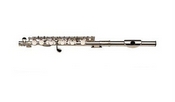
The piccolo is a member of the woodwind instrument family. It is the highest sounding instrument in a band or an orchestra.
Piccolo is not an instrument for beginning musicians. Students begin with the flute -- which is played the same way, by blowing air across the embouchure hole -- and may take up the piccolo later on as a second instrument. (This is known as "doubling".) Piccolo players read flute music, but it sounds an octave (eight notes) higher when played on the piccolo.
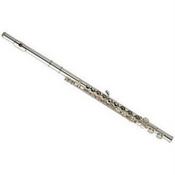
The flute is a member of the woodwind instrument family. Sound is produced by blowing across the top of the embouchure hole. The flute has several keys, which are operated by the player's left and right hands.
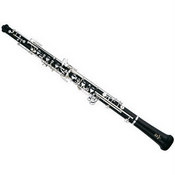
The oboe is a member of the woodwind instrument family. The oboe is known as a "double reed" instrument, as the sound is created through the vibration of two reeds that are tied together. It has several keys, which are operated by the fingers of the left and right hands. The sound of an oboe can be easily heard; even large bands and orchestras typically only have a few people playing the oboe.
The oboe looks a lot like a clarinet, but it is very different... do not confuse the two!
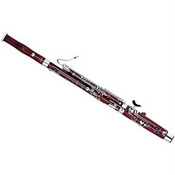
The bassoon is a member of the woodwind instrument family. Like the oboe, it is a "double reed" instrument, with sound produced from the vibration of two reeds that are tied together. There are several keys to operate and tone holes to cover using both the left and right hands. When playing the bassoon, the musician's thumbs are responsible for pressing several different keys (unlike other woodwind instruments, which typically only have one key that is pressed by the thumb).
The bassoon generally plays low notes but also is featured occasionally with melodies.
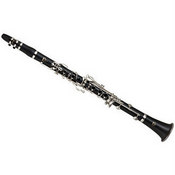
The clarinet is a member of the woodwind instrument family. There are various size clarinets. This one, technically called the soprano clarinet, is the most common size, and so it is more commonly known as simply the clarinet.
Producing sound on a clarinet requires a reed, which is attached to the mouthpiece. Reeds wear out with use and must be replaced regularly. A rental clarinet includes just one reed, so it is recommended that anyone who rents a clarinet purchase a box of reeds.
Once a student has learned the clarinet, it is relatively easy to play the saxophone. (The method of producing sound is nearly identical, and finger placement for certain notes is the same.) For this reason and because the clarinet is much lighter, some teachers suggest that young students who want to play alto saxophone begin by learning the clarinet.
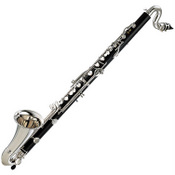
The bass clarinet is a member of the woodwind instrument family. It is larger than a soprano clarinet (the most common type of clarinet) and produces lower notes, but the bass clarinet is played just like a clarinet, with many keys operated by the player's left and right hands. The reed that vibrates to produce sounds is somewhat larger than that of a clarinet. A metal peg attached to the instrument is used to adjust the height of the bass clarinet, which is usually played sitting down.
Some people choose to learn bass clarinet as their first instrument, but most begin by first learning to play the (soprano) clarinet and eventually add the bass clarinet as a second instrument.
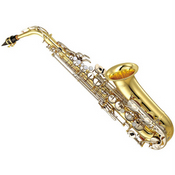
The alto saxophone (whose name is often shortened to "alto sax") is a member of the woodwind instrument family despite being made of brass. An alto saxophone is larger than the soprano sax but smaller than the tenor sax. Because it is made of metal and has many keys, this instrument is a bit heavy and so a neck strap is used to help support the instrument when playing. Sound is produced by a vibrating reed.
The alto saxophone is the size that most young students begin playing. All saxophones are played exactly the same, so once a person learns the alto saxophone, it is relatively easy to play a different size saxophone.
If your dream is to play in a symphony orchestra, the saxophone is not a good choice because orchestras typically do not include saxophones. However, saxophone is a very common instrument in concert bands, jazz ensembles, and even some rock bands.
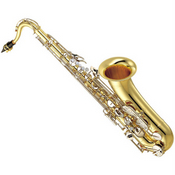
The tenor saxophone (whose name is often shortened to "tenor sax") is a member of the woodwind instrument family despite being made of brass. It is larger and heavier than an alto sax, and the tenor sax plays lower notes. Sound is produced by a vibrating reed.
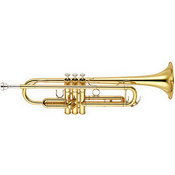
The trumpet is a member of the brass instrument family. To produce a sound on the trumpet, you have to "buzz" your lips into a small metal mouthpiece. The three valves of the trumpet, combined with the adjustment of a player's "embouchure" (muscles around the mouth) allow it to play a full range of notes.
The trumpet is a very common instrument, found in bands, orchestras, jazz ensembles, brass quintets, and other groups.
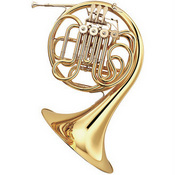
The French horn is a member of the brass instrument family. Although it is often referred to as "French horn", the instrument actually has no particular connections to the country of France, and so it is sometimes just called "the horn". Sound on the horn is produced by vibrating one's lips into a small metal mouthpiece. The horn is the only common brass instrument that requires the valves to be operated by the left hand. (Being left-handed is not a requirement, however.)
Successfully playing the horn requires the good sense of pitch, or the ability to hear notes in your head before producing the sounds with the instrument. Some teachers recommend that students who want to play the horn start with the trumpet, which has a similarly-sized mouthpiece.
Playing the horn can be tough for beginners, but practice and determination can help you succeed in learning to play this wonderful and important musical instrument.
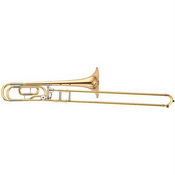
The trombone is a member of the brass instrument family. Sound on the trombone is produced by "buzzing" into a metal mouthpiece. A trombone mouthpiece is larger than a French horn or trumpet mouthpiece; some people actually find it easier to produce sound with this larger mouthpiece.
The unique characteristic of the trombone is the long slide that is moved in and out to change the pitch. There are seven basic slide positions used to play notes, which the musician needs to find by ear.
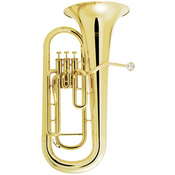
The euphonium (pronounced "you-phone-ee-um") is a member of the brass instrument family. You may also hear this instrument called the "baritone horn". (Technically the baritone horn is a slightly different instrument, but it is very similar to the euphonium and is played the same way.) Producing a sound on the euphonium requires vibrating -- "buzzing" -- the lips into a metal mouthpiece. A student model euphonium has three valves, which are operated by the player's right hand. More advanced musicians often trade-up to a model with four valves.
The euphonium is a great starting instrument for people who like low sounds and especially for anyone who may want to someday play a tuba, since the euphonium is essentially a smaller version of the tuba.
Music for euphonium is often available in treble clef (to make it easier for people who switch to euphonium from trumpet). When starting on the euphonium, however, it's best to learn to read music in bass clef since that is the clef for most euphonium literature.
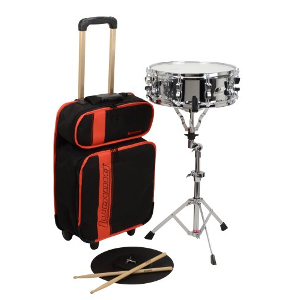
The snare drum is a member of the percussion instrument family. The characteristic sound of the snare drum is produced by the rattling of metal snares against the bottom of the drum when the top head is struck with a stick.
Becoming a good snare drum player is not as easy as it may seem; it requires excellent left and right hand coordination and muscle development. The snare drum is what is known as "unpitched percussion"... you cannot play melodies on a snare drum, just rhythms. Many drummers eventually learn to play other percussion instruments as well.
When you rent a snare drum, it comes with a rubber disc that fits on top of the drum to make it somewhat quieter when practicing. Also included is a snare drum stand and a pair of drum sticks.
Learning to play a snare drum can be the first step in playing a drum set (available for sale from Ellis Music).
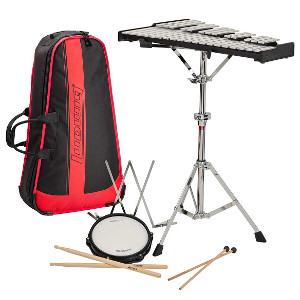
The bells are a member of the percussion instrument family. Bells are a type of pitched percussion, which means that melodies can be played with this instrument. Bars on the bells are struck with mallets to produce the sound.
Many teachers insist that beginning percussionists play bells so that they learn to read notes, which will enable them to play other pitched percussion instruments like the xylophone, vibraphone, marimba, and timpani (in addition to snare drum and unpitched percussion).
When you rent the bells, it's part of a "percussion kit" that includes a practice pad and sticks -- for learning to play snare drum -- as well as a stand that will hold either the bells or the practice pad.
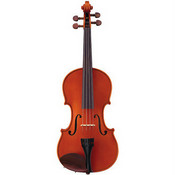
The violin is a member of the string instrument family. Sound on the violin is produced by moving the bow across the strings, or by plucking the strings. The violin may be best known as an orchestra instrument, but it is also an important bluegrass instrument and is used in a variety of genres, including country music. The term "fiddle" is just another name for the violin.
These are general guidelines for help in determining the correct instrument size. The best option is to have the teacher size the student, and always defer to the teacher's judgment in sizing. It is important for the player to be comfortable to avoid issues that may develop over time from playing an improperly sized instrument.
The chart below is a good guideline for violin sizing. Have the player stand with left arm fully extended to the side, then measure the distance from the neck to the middle of the palm. Refer to the chart to determine the best size. The student's age may also give you some idea of the size. Remember that everyone grows at a different rate. It is important for the player to be comfortable to avoid physical issues.
When supporting the instrument under the chin in playing position, if the instrument is the proper size, the palm and fingers of the left hand should be able to comfortably cup the scroll.
| Violin Size | Arm Length | Player's Age |
|---|---|---|
| 1/16 | 14"-15" | 3 to 4 years old |
| 1/10 | 15"-17" | 4 to 5 years old |
| 1/8 | 17"-18" | 5 to 6 years old |
| 1/4 | 18"-20" | 6 to 7 years old |
| 1/2 | 20"-22" | 8 to 9 years old |
| 3/4 | 22"-23" | 10 to 11 years old |
| 4/4 | 23"+ | 12 years and older |
7/8 size violins are also available by special request. These are sometimes used by smaller adults or people with small hands.

The viola is a member of the string instrument family. Sound on the viola is produced by moving the bow across the strings, or by plucking the strings. A viola looks just like a violin, except that it's a bit larger. The sound is a bit lower and has a different tone quality. One unique thing about the viola is that music for it is typically written in the alto clef.
Violas are available in smaller sizes to accommodate young students. Violas sizes are based on the length of the body of the instrument.
These are general guidelines for help in determining the correct instrument size. The best option is to have the teacher size the student, and always defer to the teacher's judgment in sizing. It is important for the player to be comfortable to avoid issues that may develop over time from playing an improperly sized instrument.
Violas smaller than 12" tend to be very hard to play because of the short scale length. The strings will be very loose, and hard to bow. String makers are working on better technology to accommodate small violas, but for now it may be better to start on a ¼ (or smaller) violin rather than an 11" viola. As always, consult with your teacher to determine the best way to suit the player's needs.
The chart below is a good guideline for viola sizing. Have the player stand with left arm fully extended to the side, then measure the distance from the neck to the middle of the palm. Refer to the chart to determine the best size. The student's age may also give you some idea of the size. Remember that everyone grows at a different rate. It is important for the player to be comfortable to avoid physical issues.
When supporting the instrument under the chin in playing position, if the instrument is the proper size, the palm and fingers of the left hand should be able to comfortably cup the scroll.
| Viola Size | Arm Length | Player's Age |
|---|---|---|
| 11" | 18"-20" | 5 years and under |
| 12" | 20"-22" | 6 to 9 years old |
| 13" | 22"-23" | 6 to 9 years old |
| 14" | 23"-25" | 9 to 11 years old |
| 15" | 25"-26" | 11 to 12 years old |
| 16" | 26"-27" | 13 years to adult |
| 16.5"+ | 27"+ | large adult |
There are also a few sizes of viola not listed. For example; some people use 15½" violas for someone who is fully grown or nearly so, but does not quite fit into a 16" viola. As the viola evolved from an instrument played on the lap to an instrument played on the shoulder it is naturally a little larger than is comfortable on the shoulder. Violists often try to play the largest pattern they can manage, but too large of an instrument will cause physical injury over time with frequent playing. Student models are more limited in sizing, but the instruments don't fall quite as neatly into 1-inch increments as one might guess. If you have trouble finding a comfortable instrument let us know, and we will do what we can to help.
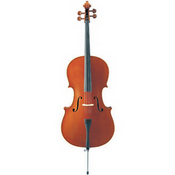
The cello is a member of the string instrument family. The cello is usually played sitting down.
Cellos are available in fractional sizes (1/4, 1/2, etc) to accommodate young students. Eventually most people end up playing a full-size cello.
These are general guidelines for help in determining the correct instrument size. The best option is to have the teacher size the student, and always defer to the teacher's judgment in sizing. It is important for the player to be comfortable to avoid issues that may develop over time from playing an improperly sized instrument.
To size an instrument, the player should sit so that the knees are bent at a 90 degree angle. The instrument should rest such that the upper rim rests on the sternum and the left knee contacts the curve below the lower bout corner. The C-string peg should be near the left ear, with the neck a few inches from the shoulder, and the left hand should be able to reach both ends of the fingerboard with ease. The first and fourth fingers of the left hand should be able to comfortably span a major third on the D string.
| Cello Size | Height | Arm Length | Finger Span | Player's Age |
|---|---|---|---|---|
| 1/16 | under 4 years old | |||
| 1/10 | 4 to 5 years old | |||
| 1/8 | 3.5 to 4 feet | 4 to 6 years old | ||
| 1/4 | 3.5 to 4 feet | 18" to 20" | 3" to 4" | 6 to 8 years old |
| 1/2 | 4 to 4.5 feet | 20" to 22" | 4" to 5" | 8 to 10 years old |
| 3/4 | 4.5 to 5 feet | 22" to 24" | 5" to 6" | 10 to 12 years old |
| 4/4 | 5+ feet | 24" and up | 6"+ | 12 years and older |
7/8 size cellos are also available by special request. These are sometimes used by smaller adults or people with small hands.
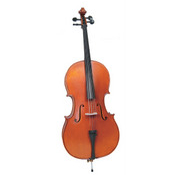
The bass is a member of the string instrument family. You may also hear people refer to it as the double bass, upright bass, string bass, or acoustic bass. It is the lowest pitched string instrument. The bass is sometimes played with a bow and is sometimes plucked. Orchestral music often calls for both techniques to be used. There is a device called a pickup that can be installed on an acoustic bass to amplify it.
Rock and popular music typically calls for an electric bass, which is very closely related but is a different instrument. (It's smaller and looks like an electric guitar.)
The bass is available in smaller sizes to accommodate young students. Although basses advertised as 7/8 or 4/4-size do exist, the 3/4-size double bass is by far the most common and is the standard size for most musicians.
Bass sizing is less standard than many other instruments, so it is difficult to give hard and fast rules for sizing students. See the age charts below for a rough guideline, but double-check the size with your teacher. It is important for the player to be comfortable and not struggle with an improperly sized instrument. The standard size bass for adults is ¾. 7/8 and 4/4 size basses are made, but less commonly used.
With an instrument in hand you can check the size as follows; when the player and bass are both standing upright the bridge should be about the same height as the player's right hand and the fingerboard nut should be opposite the forehead near eye level. The student should be able to reach the end of the fingerboard easily.
| Bass Size | Height | Player's Age |
|---|---|---|
| 1/8 | 3.5 to 4 feet | 5 to 7 years old |
| 1/4 | 4 to 4.5 feet | 7 to 9 years old |
| 1/2 | 4.5 to 5.5 feet | 9 to 13 years old |
| 3/4 | over 5 feet | over 13 years old |
Bass bows come in one of two styles: French or German. Each has its own shape and is held differently. The French bow is held like the bows of other orchestral string instruments, while the German bow is held with an underhand grip. If you do not know what type of bow to get, please ask your music teacher.
This is what a French bow looks like: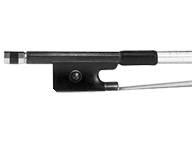 |
This is what a German bow looks like: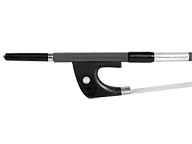 |
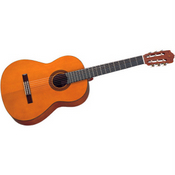
The guitar is a member of the string instrument family. It is a "plucked" instrument with six strings. Guitars are available in smaller sizes to accommodate young musicians.
Most beginners learn to play on an acoustic guitar, which projects its sound naturally. Electric guitars (commonly used in popular music) require an amplifier to be heard but can produce special effects through the use of pedals. Acoustic-electric guitars combine the features of both.
Though any guitar can be used to play any style of music, steel string guitars are more common for pop/rock and nylon string guitars are more common for classical music. Steel string guitars can be identified (among other ways) by the top two strings, which are plain steel, as well as tuning knobs that typically point outward, bridge pins that hold the strings in place, and a pick guard on the body of the instrument. Nylon string guitars can be identified (among other ways) by the top two strings, which are nylon, as well as tuning knobs that point toward the back of the instrument, a slotted headstock, and a fingerboard that follows the contour of the sound hole.
Determining the correct size guitar is difficult, as there is no simple measurement to take. See the age chart below for a rough guideline, but it is recommended that you seek guidance from your music teacher.
| Guitar Size | Player's Age |
|---|---|
| 1/2 | under 12 years old |
| 3/4 | 12 to 14 years old |
| 4/4 (full size) | over 14 years old |
Customer Service
Store Policies & Info


© 2011-2025 Ellis Music Company Inc. All Rights Reserved. Powered by AspDotNetStorefront.
Prices displayed on this site are for in-stock quantities only and are subject to change without notice. Sorry, but typographical errors in prices cannot be honored.
General Site Disclosures
We improve our products and advertising by using Google Analytics and Microsoft Clarity to see how you use our website. By using our site, you agree that Ellis Music, Google, and Microsoft can collect and use this data. Refer to our privacy policy for more details. Financial transactions are facilitated by a PCI-compliant third-party processor; payment card information entered on this site is securely stored by the payment processor so that Ellis Music can complete requests and fill orders.
If you have not already done so, you can login to your account to see any items that may be saved in your cart. Once logged in, you may also add items to the cart that you saved previously to your wishlist.